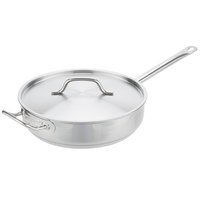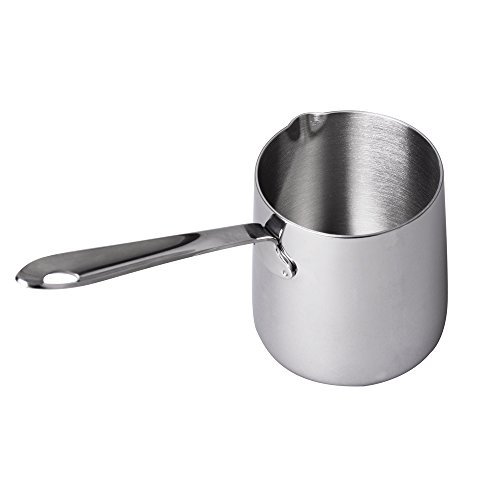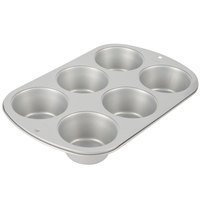While we live in a society of convenience, better meals are prepared the old fashioned way – on the stove and/or the oven. Stove and oven cooking requires cookware, namely pots and pans. Choosing the right cookware to fit your kitchen’s needs is vital to the day-to-day operations of your kitchen.
There are many different types of cookware to help you saute vegetables, create a great soup, or roast the perfect main entree.The thing is there are all kinds of cookware options these days. You can buy a specific pot or pan for pretty much any type of dish or purpose.
Cookware Materials
Aluminum

It is a good conductor of heat and does not easily distort when exposed to high temperatures. Aluminum works well for sautéing and frying foods because if its heat responsiveness. The drawback of aluminum is that it reacts to acidic and alkaline foods, causing it to corrode and affect the taste of the food being cook. Aluminum is generally used as a core heat conductor, or coated with stainless steel or an anodized coating to protect the food.
Anodized Aluminum

This has been given a special finish to protect it from corrosion. It is a good conductor of heat and the special finish makes it stick-resistant. It is a good choice of material to look for in pots and pans for most any type of cooking. Pots and pans made from anodized aluminum are not dishwasher safe and can be dark in color, making it hard to see slight color changes in the food being cooked.
Cast Iron

Cast iron cookware is inexpensive to moderately priced. It is fairly heavy and conducts heat evenly. It heats slowly but once it is hot it holds the heat well. This makes it good for deep frying and slow-cooking. It can be used on top of the stove and in the oven. Drawbacks to cast iron are that it rusts, stains and becomes pitted when exposed to air, moisture and certain foods.
Non-Stick

These pots and pans have had a coating applied to them that prevents food from sticking and makes clean up easier. The non-stick surface is really an advantage when cooking some foods, such as omelettes, and when reheating sticky foods, such as rice. It also reduces the amount of fat that is normally required when cooking. The non-stick surface is less efficient when using certain cooking methods, such as sautéing, because the coating interferes with the transfer of heat from the underlying pan.
Porcelain

Porcelain enamel is applied as a coating only on pots and pans made of other material, such as cast iron or aluminum. It prevents them from corroding or reacting with the food being cooked. A pan coated with porcelain on the inside cannot be used for sautéing or frying but will work as a saucepan and can be used in the oven.
Stainless Steel

Stainless steel is a good material for any type of pan because it does not corrode and does not react with alkaline or acidic materials. The one problem with stainless steel is that it does not conduct heat well. To combat this problem, pots and pans made from stainless steel have should have a thick aluminum or copper core in the bottom of the pan to help conduct heat more evenly and make the pan more responsive to heat. In the better quality pans, the aluminum or copper core also runs up the sides. You may find a stainless steel pan with an aluminum or copper plate on the bottom but if the plate is not thick enough, it will not do an efficient job of conducting heat evenly.
Tempered Glass

Available as flameproof and ovenproof glassware. Both types of glassware hold heat well but are not heat responsive. The flameproof glassware, which is fairly expensive, can be used in the microwave, on the stovetop and in the oven. It heats unevenly, resulting in hot spots that cause food to stick. Ovenproof glassware can be used in the microwave and in the oven, but if used on the stovetop, it must be used with a diffuser.
Types of Cookware
Chef’s Pan

A medium depth pan that generally has flared or rounded sides but is sometimes found with straight sides. It has a flat bottom and wide mouth, which accelerates the evaporation of liquids. A chef’s pan most often will have a long handle and a tight fitting cover. It is made of a metal with a thick ground base that allows temperature changes to occur rapidly as the level of the heat applied to it changes, either increasing or decreasing for the best heat conduction.
Chestnut Pan

Made in the shape of a wide-walled pan or a skillet, this roasting utensil is designed specifically for heating the large, brown shell variety of chestnuts over a stove or heat source such as fire, gas or hot coals. Roasting chestnuts over an open fire is best accomplished with a longer handled roasting pan or basket made from steel wires like a steel cooking basket, while the deep-walled or skillet-like pan is best for coals, gas or electric heat. Formed with large-sized holes in the bottom, the Chestnut Pan allows the heat to have greater exposure to directly heating the chestnuts in a shell as they cook.
Fry Pan / Sauteuse

Curved side walls for easy stirring and sliding food out of the pan, Ideal for frying, scrambling, sauteing or searing, Sloped sides prevent steam from forming in the pan
Saute pan / Sautoir

Wide bottom area for maximum heat conduction, Ideal for sauteing, searing, braising, deglazing, poaching, and stir frying, Straight, high sides help contain food and expose all sides to heat
Wok

Feature flat bottoms, or round bottoms for high heat concentration. Round bottom woks require a wok ring to sit on a standard burner, Ideal for stir frying or wok applications, Deep curved sides promote excellent food movement, Mandarin woks feature a single standard handle while Cantonese woks feature two loop handles
Tapered Sauce Pan

Small bottom diameter for less heat exposure, Flared sides allow for good stirring action, Ideal for cooking at lower temperatures for a longer time
Sauce Pot

Wide bottom area for maximum heat conduction, Ideal for slow cooking stews, sauces, soups, casseroles and roasts while reducing the content
Two loop handles for easier pouring and movement
Stock Pot

Thick base for a good slow simmer ,Ideal for stocks, soups, pastas, bulk vegetables and seafood. Smaller diameter and taller height of pot preserves liquids longer and forces the liquid to bubble up through the ingredients, maximizing flavor transfer. Steam baskets are often used in stock pots to cook food with steam
Roasting Pan

Handles allow for easy oven loading and unloading, as well as convenient transportation. Heavy duty construction and large size accommodate roasts.
Paella Pan

Flat and shallow construction with sloping sides helps paella cook evenly and allows for the toasting of rice in the bottom of the pan. Side handles allow for easy maneuverability. Compatible with all heat sources
Egg Poacher

Individual cups consistently provide evenly-shaped poached eggs
Models available with 4-15 cups for high volume efficiency
Skillet

Cast iron heats evenly and consistently with no “hot spots” so foods cook better with less chance of scorching. Long-lasting construction lets it easily go from oven-to-table for fast, efficient service. Ideal for sauteing, searing, frying, and even baking
Dutch Oven

Cast aluminum heats evenly and consistently with no “hot spots” so foods cook better with less chance of scorching. Ideal for stews or baked dishes. Resists sticking and rust. Lightweight and easy to maneuver around a fast paced kitchen
Steamers

A steamer pot is one with a metal screen that sits inside above the bottom. You place water on the bottom and the steam cooks whatever you put in the steam insert. This is great for steaming vegetables. Steamed broccoli this way is one of my favorites.
Pasta pots

A pasta pot is designed to cook pasta. There are two main types of pasta pots.The first is one with a perforated locking lid so that you can pour the water out and be left with cooked pasta.
Double boilers

A double boiler is like a steamer, except the insert is a pot with no holes. These are good for food that cooks best with steam heat such as melting chocolate. Here’s an example:
Casserole pots

While you can definitely cook casseroles in a dutch oven or slow cooker, you can also buy specific pots designed for making casseroles such as the following low-rise casserole pot.
Milk warmer

Most kitchens won’t get a milk warmer, but if you like warm milk and prefer not doing it in a small sauce pot, you can actually buy a pot designed for warming milk on the stove.
Grill pans

A grill pan is designed to replicate grill cooking on the stove.
Roasting pans

A roasting pan is for roasting large pieces of meat. The pan is usually rectangle in shape with a rack sitting on the bottom suspending the meat above the bottom.
Omelette Pan

An omelette pan is basically the same as a frying pan. It is available made from the same type of material as frying pans and is generally shaped the same. An omelette pan with a non-stick surface is beneficial when making omelettes because it allows the eggs to release from the pan, making them easier to turn or flip. The omelette pan is also available in an oval shaped pan . The oval pan works well for cooking foods such as omelettes, fish filets, and shell steaks.
Types of Bakeware
Food Cake Pan

Tubular design with a hollow core allows for even heating,Ideal for angel food cakes and bundt cakes, Straight sides, and non-stick surface help the cake rise, Three cooling legs allow the cake to cool upside down as required
Glass Baking Pan

A baking pan made from tempered glass. The glass may be flameproof or ovenproof and are available in square and rectangular shapes of various sizes. The flameproof glassware, which is fairly expensive, can be used in the microwave, on the stovetop and in the oven. Ovenproof glassware can be used in the microwave and in the oven, but if used on the stovetop. The glass baking dish is used to bake fish, meats, casseroles, vegetable dishes, breads, cakes and other desserts.
Bread Loaf Pan

Deep construction allows for high rising, Perfect for bread, cake, and pudding, Excellent heat conduction permits low temperature baking for optimum results
Sheet Pan

The workhorse of any bakery. Thin sheet ideal for baking cookies, rolls, and other foods that don’t produce a lot of liquids. Upturned lips prevent products from sliding off and allow for easy handling
Cake Pan

Straight side walls for a clean, easy release.Ideal for baking cakes and deep dish pizzas
Muffin Pan

Models available with 6 – 48 cups for high volume efficiency, Ideal for mini, standard, and jumbo sized muffins or cupcakes.
Pie Pan

Angled sides prevent crust from slumping ,Wide rim allows for simple fluting
Tart Pan

Straight, fluted sides for a crisp, presentable crust ,Removable bottom permits taking out a tart without damaging its crust
Conclusion
Please choose cookware wisely as per your cooking requirements. all the pots and pans available on different e-commerce sites and even on local market.




